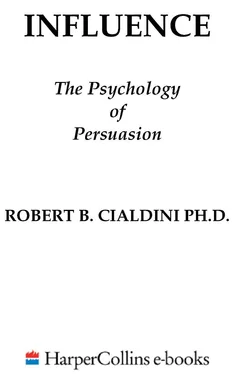2. It is important to note that the collaboration was not always intentional. The American investigators defined collaboration as "any kind of behavior which helped the enemy," and it thus included such diverse activities as signing peace petitions, running errands, making radio appeals, accepting special favors, making false confessions, informing on fellow prisoners, or divulging military information.
3. The Schein quote comes from his 1956 article "The Chinese Indoctrination Program for Prisoners of War: A Study of Attempted Brainwashing."
4. See Greene (1965) for the source of this advice.
5. Freedman and Fraser published their data in the Journal of Personality and Social Psychology, in 1966.
6. The quote comes from Freedman and Fraser (1966).
7. See Segal (1954) for the article from which this quote originates.
8. See Jones and Harris (1967).
9. It is noteworthy that the housewives in this study (Kraut, 1973) heard that they were considered charitable at least a full week before they were asked to donate to the Multiple Sclerosis Association.
10. From "How to Begin Retailing," Amway Corporation.
11. See Deutsch and Gerard (1955) and Kerr and MacCoun (1985) for the details of these studies.
12. From Whiting, Kluckhohn, and Anthony (1958).
13. From Gordon and Gordon (1963).
14. The survey was conducted by Walker (1967).
15. The electric-shock experiment was published seven years after the Aronson and Mills (1959) study by Gerard and Mathewson (1966).
16. Young (1965) conducted this research.
17. The robot study is reported fully in Freedman (1965).
18. The reader who wishes stronger evidence for the action of the lowball tactic than my subjective observations in the car showroom may refer to articles that attest to its effectiveness under controlled, experimental conditions: Cialdini et al. (1978), Burger and Petty (1981), Brownstein and Katzev (1985), and Joule (1987).
19. A formal report of the energy-conservation project appears in Pallak et al. (1980).
20. It is not altogether unusual for even some of our most familiar quotations to be truncated by time in ways that greatly modify their character. For example, it is not money that the Bible claims as the root of all evil, it is the love of money . So as not to be guilty of the same sort of error myself, I should note that the Emerson quote from "Self-Reliance" is somewhat longer and substantially more textured than I have reported. In full, it reads, "A foolish consistency is the hobgoblin of little minds adored by little statesmen, and philosophers, and divines."
21. See Zajonc (1980) for a summary of this evidence.
22. This is not to say that what we feel about an issue is always different from or always to be trusted more than what we think about it. However, the data are clear that our emotions and beliefs often do not point in the same direction. Therefore, in situations involving a decisional commitment likely to have generated supporting rationalizations, feelings may well provide the truer counsel. This would be especially so when, as in the question of Sara's happiness, the fundamental issue at hand concerns an emotion (Wilson, 1989).
CHAPTER 4 (PAGES 114-166)
1. The general evidence regarding the facilitative effect of canned laughter on responses to humor comes from such studies as Smyth and Fuller (1972), Fuller and Sheehy-Skeffinton (1974), and Nosanchuk and Lightstone the last of which contains the indication that canned laughter is most effective for poor material.
2. The researchers who infiltrated the Graham Crusade and who provided the quote are Altheide and Johnson (1977).
3. See Bandura, Grusec, and Menlove (1967) and Bandura and Men-love (1968) for full descriptions of the dog-phobia treatment.
Any reader who doubts that the seeming appropriateness of an action is importantly influenced by the number of others performing it might try a small experiment. Stand on a busy sidewalk, pick out an empty spot in the sky or on a tall building, and stare at it for a full minute. Very little will happen around you during that time—most people will walk past without glancing up, and virtually no one will stop to stare with you. Now, on the next day, go to the same place and bring along four friends to look upward too. Within sixty seconds, a crowd of passersby will have stopped to crane their necks skyward with the group. For those pedestrians who do not join you, the pressure to look up at least briefly will be nearly irresistible; if your experiment brings the same results as the one performed by three New York social psychologists, you and your friends will cause 80 percent of all passersby to lift their gaze to your empty spot (Milgram, Bickman, and Berkowitz, 1967).
4. Other research besides O'Connor's (1972) suggests that there are two sides to the filmed-social-proof coin, however. The dramatic effect of filmed depictions on what children find appropriate has been a source of great distress for those concerned with frequent instances of violence and aggression on television. Although the consequences of televised violence on the aggressive actions of children are far from simple, the data from a well-controlled experiment by psychologists Robert Liebert and Robert Baron (1972) have an ominous look. Some children were shown excerpts from a television program in which people intentionally harmed another. Afterward, these children were significantly more harmful toward another child than were children who had watched a nonviolent television program (a horserace). The finding that seeing others perform aggressively led to more aggression on the part of the young viewers held true for the two age groups tested (five-to-six-year-olds and eight-to-nine-year-olds) and for both girls and boys.
5. An engagingly written report of their complete findings is presented in Festinger, Riecken, and Schachter's (1956) book When Prophecy Fails.
6. Perhaps because of the quality of ragged desperation with which they approached their task, the believers were wholly unsuccessful at enlarging their number. Not a single convert was gained. At that point, in the face of the twin failures of physical and social proof, the cult quickly disintegrated. Less than three weeks after the date of the predicted flood, group members were scattered and maintaining only sporadic communication with one another. In one final—and ironic—dis-confirmation of prediction, it was the movement that perished in the flood.
Ruin has not always been the fate of doomsday groups whose predictions proved unsound, however. When such groups have been able to build social proof for their beliefs through effective recruitment efforts, they have grown and prospered. For example, when the Dutch Anabaptists saw their prophesied year of destruction, 1533, pass uneventfully, they became rabid seekers after converts, pouring unprecedented amounts of energy into the cause. One extraordinarily eloquent missionary, Jakob van Kampen, is reported to have baptized one hundred persons in a single day. So powerful was the snowballing social evidence in support of the Anabaptist position that it rapidly overwhelmed the disconfirming physical evidence and turned two thirds of the population of Holland's great cities into adherents.
7. From Rosenthal's Thirty-eight Witnesses, 1964.
8. This quote comes from Latané and Darley's award-winning book (1968), where they introduced the concept of pluralistic ignorance.
The potentially tragic consequences of the pluralistic ignorance phenomenon are starkly illustrated in a UPI news release from Chicago:
A university coed was beaten and strangled in daylight hours near one of the most popular tourist attractions in the city, police said Saturday.
Читать дальше












